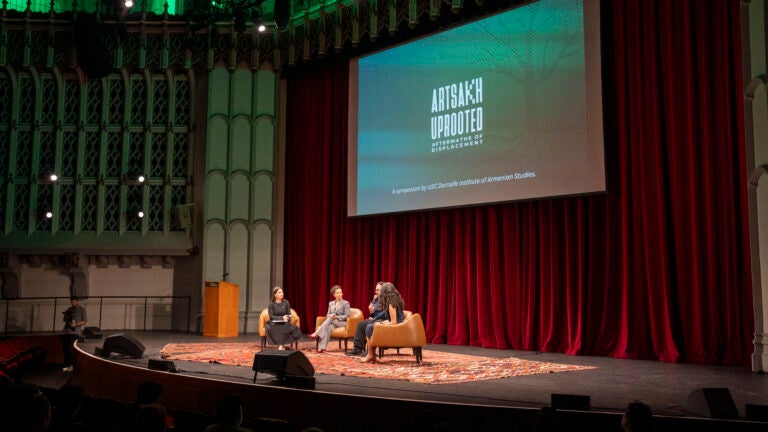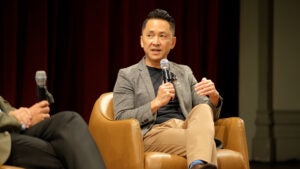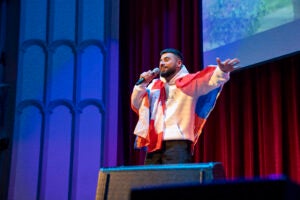
Margarita Baghdasaryan, Shoushan Keshishian, Ashot Gabrielyan, and Nina Shahverdyan at Artsakh Uprooted, Photo by Brandon Balayan
Institute Hosts Unprecedented Symposium on Artsakh
More than 1,000 people gathered at USC’s Bovard Auditorium on Saturday, November 2 for Artsakh Uprooted: Aftermaths of Displacement, a groundbreaking symposium hosted by the USC Dornsife Institute of Armenian Studies.
The program included a vibrant mix of academic panel discussions, multimedia artistic presentations, and live performances that highlighted the Armenian experience in the global conversation on dispossession and cultural erasure.

Interim Dean of the USC Dornsife College of Letters, Arts, and Sciences Mohamed El-Naggar opened the program with remarks on how exile grants unique insights, as displaced peoples often exist in a liminal space between their original and adopted societies.
The program approached the topic of displacement through diverse angles and perspectives, including those of people from Artsakh, Armenian Studies experts, and USC scholars from across disciplines.
In a panel discussion moderated by Institute Associate Director Margarita Baghdasaryan, Ashot Gabrielyan, Shoushan Keshishian, and Nina Shahverdyan shared unfiltered accounts of their displacement from Artsakh and the challenges that have followed.
Institute Director Shushan Karapetian moderated a panel on the role of the Armenian dialects of Artsakh as witness to survival and dispossession. The discussion featured prominent linguist Hrach Martirosyan and Artsakh-born journalist Lika Zakaryan.
Stephan Astourian, Director of the Turpanjian Center for Policy Analysis at the American University of Armenia, and former Artsakh State Minister Artak Beglaryan delivered keynote lectures that traced the history and path forward for Artsakh.

In a rousing conversation with filmmaker Eric Nazarian, Pulitzer Prize-winning author and USC Aerol Arnold Chair of English Viet Thanh Nguyen emphasized the importance of abolishing the conditions that render certain groups voiceless.
The day also included an array of artistic content that allowed guests to learn about Artsakh through different mediums and modes of expression.
In an original performance lecture, USC School of Architecture Assistant Professor Aroussiak Gabrielian and Hyperallergic Editor-in-Chief Hrag Vartanian offered a multimedia journey derived from the ancestral wisdom of Artsakh’s Tnjri Plane tree. The presentation featured musical accompaniment by Raffi Wartanian on oud and Armen Adamian on duduk, and attendees received seeds of the tree as living mementos.
 Investigative researcher Simon Maghakyan delivered a dynamic visual presentation on how Armenians can reclaim agency in response to destruction of their ancient cultural heritage around the world.
Investigative researcher Simon Maghakyan delivered a dynamic visual presentation on how Armenians can reclaim agency in response to destruction of their ancient cultural heritage around the world.
Filmmaker and USC Annenberg School for Communication and Journalism graduate Balin Schneider premiered his short film My Dearest Artsakh, which centers the story of a displaced teenager who seeks to find her place in Armenia against the backdrop of unimaginable longing.
USC Vice Provost for the Arts and MacArthur Fellow Josh Kun introduced Artsakh-born rapper Lyoka with captivating remarks that underscored the power of sound for displaced communities across the globe. Lyoka delivered an electric performance that captured the day’s dual themes of loss and resilience.

Through this monumental program, the Institute debuted a pioneering form of intellectual engagement with Armenian Studies — combining academia and the arts to touch both the mind and soul.
Video recordings of the program components will be available on the Institute’s YouTube channel in the coming weeks. We invite attendees to submit feedback in this post-event survey, which will provide insights for future programming.
The symposium was co-sponsored by Massis Kabob, USC Visions and Voices, USC Divisional Dean for the Social Sciences, NAASR, Armenian Film Society, and UCLA Promise Armenian Institute.

























